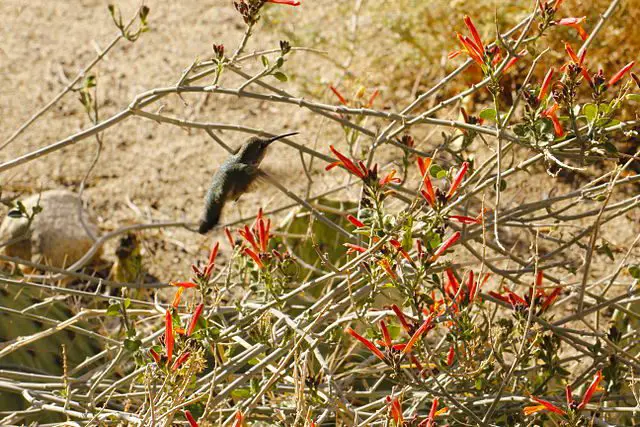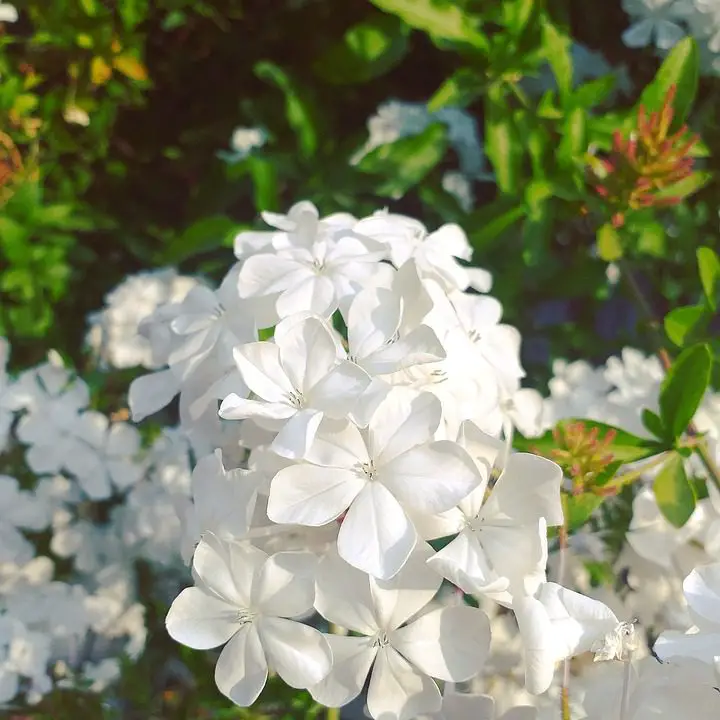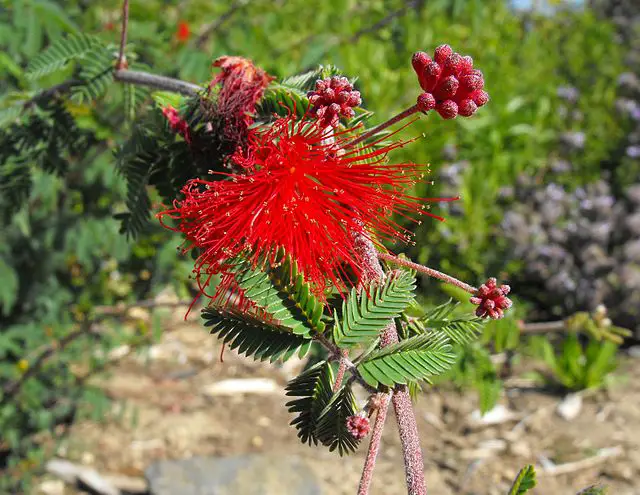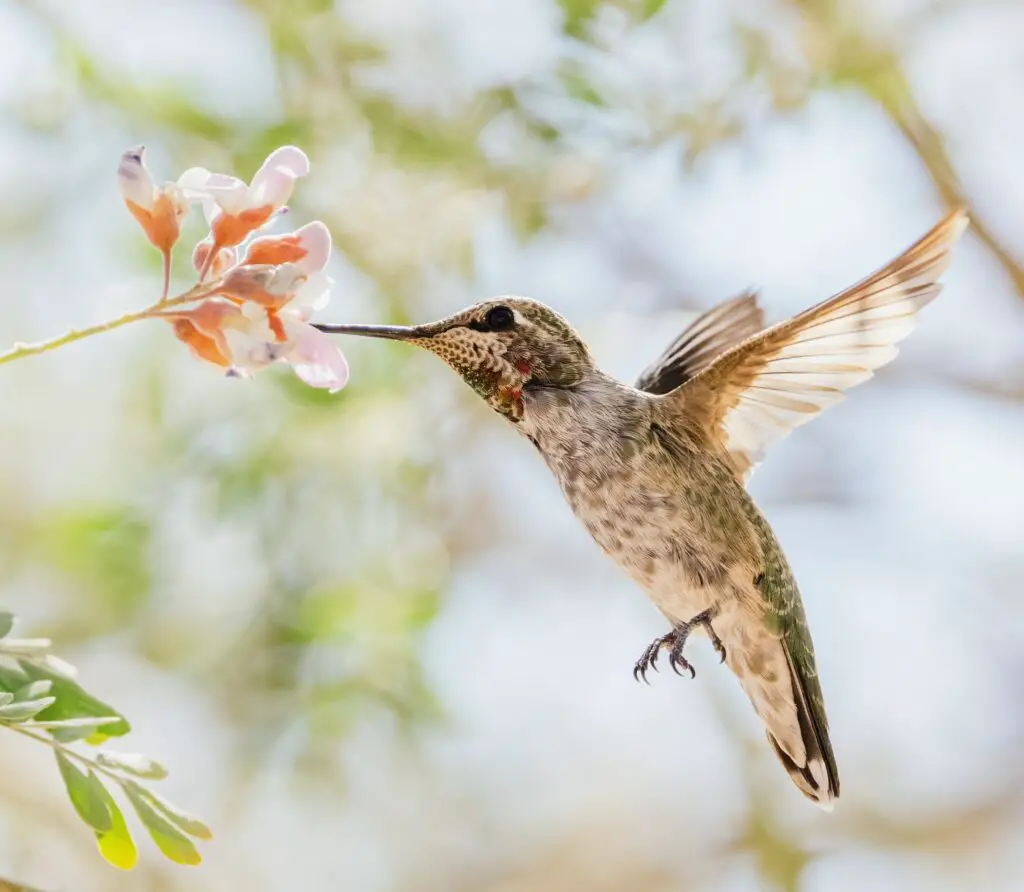Flowering desert plants, such as these select groups of shrubs, trees, succulents, and cacti, are highly drought resistant. Another term for plants that survive in dry areas is xeric plants.
A hardy desert landscape doesn’t need to look dull, nor just contain cacti and succulents! If you’re fond of bright, showy flowers embellishing your dry landscape (and attracting birds, bees, and butterflies), you came to the right place.
Deserts aren’t all about sand, rocks, snakes and spiders, there are actually some very pretty plants that thrive in desert regions.
Here are the most colorful, interesting, and low-maintenance flowering plants that are perfect for your desert garden.
Table of Contents
Flowering Desert Plants
An astounding variety of low-water-use landscaping plants like living in arid areas. With a bit of creativity, you can design a planting plan for your dry desert property to fit any scenery!
Desert plants exist in such a rainbow of colors, textures, and shapes that they can turn barren areas into spectacular attractions. Some of these will get you thinking, “What? I didn’t know flowers could look like that!”
Shrubs

A shrub is clearly defined as a woody plant with multiple stems. I bet you’re surprised that we didn’t immediately delve into succulents or cacti.
Sand or rocky soil, scorching temperatures, and almost no precipitation are the defining characteristics of the desert environment. There are shrubs that can live in these extreme conditions! It’s not just for cacti.
Here are some tough flowering shrubs that can add a pop of color to your desert landscape.
Chuparosa (Justicia californica)

Chuparosa (“hummingbird” in Spanish), also known as Beloperone or Hummingbird Bush, is a native, brightly flowering desert shrub. It is a member of the Acanthus family (Acanthaceae), which composes mostly tropical plants.
Justicia californica can grow up to six feet tall and eight feet wide. You can readily notice its profusion of tubular, red (or orange) blooms against its small, pale green leaves and dense branches. It will certainly stand out in the landscape due to its unique growth habit.
You can naturally find this plant growing in Mexico, Arizona, and California’s sandy areas. If you are lucky enough to get a Chuparosa in your landscape, you can expect birds such as sparrows, hummingbirds, and linnets to be attracted to its nectar-filled flowers.
Bougainvillea (Bougainvillea spectabilis)

Bougainvillea spectabilis is a well-known flowering desert plant for landscaping. You can usually see it in Mediterranean settings. It’s a woody, ornamental shrub that can grow quite big (15-40’ tall and wide), and its defining characteristic is the striking (usually) magenta color of the inflorescence.
This large plant will certainly stand out in the landscape and give off a tropical vibe. Its remarkably vibrant, paper-thin bracts enclosing the tiny, white flowers will unmistakably add a lot more color to your yard.
White Plumbago (Plumbago zeylanica)

Plumbago zeylanica is a non-woody, spreading plant that flowers year-round. This plant can be called White Plumbago, Doctorbush, Ceylon leadwort, or Wild Leadwort.
Wherever you put this plant in your landscape, you can’t go wrong. Its abundance of white blooms makes it a beautiful container plant, accent, hedge, or ground cover. It’s also really good at erosion control.
Although they will survive harsh, dry conditions, they do appreciate a drink from time to time when it gets really dry. These plants like well-draining soil.
Arizona Rosewood (Vauquelinia californica)

Vauquelinia californica is an evergreen, ornamental shrub belonging to the Rosaceae family (Roses). It is a native, non-toxic substitute for oleander. And, even though early summer blossoming is not as magnificent and lasts only a few weeks, it is still worth seeing.
Arizona Rosewood produces tiny white blooms in umbels at the branch tips. This flowering plant is mostly used in arid settings or low-water landscapes. This plant can withstand all weather conditions, except for perhaps some of the warmest days of the year when you may see its leaves turn yellow.
This beautiful shrub is best pruned only to shape. You don’t want to cut off too much, especially if you want it to reach its maximum height (20 feet).
Oleander (Nerium oleander)

The most important thing you need to know about Nerium oleander: it is a poisonous plant. Even the smoke from burning the plant can be deadly.
Oleandrin and neriine are two highly powerful cardiac glycosides (cardenolides) that may be found throughout the plant. Oleander cultivars with red flowers tend to be more poisonous. Even when oleander is dried, it retains its toxicity. A single leaf can be fatal to a youngster who eats it. However, human mortality is minimal. Even touching the leaves and blossoms can irritate the skin and induce allergic responses.
Oleanders bloom from early spring to late summer, bearing enormous clusters of white, yellow, red, or pink flowers at the ends of the stalks. They like full sun to develop and bloom but may accept the moderate shade.
Yellow Bells (Tecoma stans)

Yellow Bells (also known as Esperanza, a Spanish word for “hope,” Trumpet Flower, Yellow Elder, Yellow Bignonia, and Yellow Trumpet Flower) is an evergreen plant with an irregular form. It grows 3-6 feet tall in the United States. However, it can reach a height of 10-25 feet and a width of 10-20 feet. It has a lot of stems and tall, thin branches.
In direct sunlight, Yellow Bells will flower abundantly. Against the lance-shaped, olive-green foliage, clusters of big, eye-catching, trumpet-shaped yellow blooms stand out, which explains its name. And in the fall, long, slender pods appear.
It grows best in organically rich, damp, well-drained alluvial and calcareous soils with high pH values. Letting the shrub dry out between waterings is beneficial.
Yellow Bells is indeed a popular landscape plant, prized for its drought resistance as well as its stunning beauty.
Bee Brush (Aloysia gratissima)

Here’s a little trivia about Aloysia gratissima: headaches, bronchitis, and nervous system problems can be treated using the aerial portions of this plant species. And it’s been shown to have antidepressant-like effects.
Bee Brush or Whitebrush is another beautiful flowering plant. It produces torrents of small, intensely vanilla-scented blooms after rainfall during the summer months. And when it does, it attracts bees (hence the name) and butterflies. It blooms even more in full sunlight.
You can trim this plant into a tiny tree or a hedge! For most soil types, this plant makes a good backdrop or barrier plant. And if you want to encourage even more blooming and noticeably thicker growth? Just prune it.
Ocotillo (Fouquieria splendens)

Ocotillos are among the most unusual-looking flowering desert plants. They look rather amusing with their long, spiny, bent sticks standing out against an arid hillside. They can be the perfect desert accent plant for many yards.
Although ocotillos are classified as woody shrubs, they also contain characteristics of succulent plants, like drought resistance and the capacity to come back to life with some rain. You can see when an ocotillo becomes dormant between showers. Each region of growth along the stem will be divided by a line.
The name Ocotillo (Spanish for “small torch”) comes from the groups of brilliant, fiery red blooms that grow at the plant’s stem terminals. But it has many other nicknames: Jacob’s Staff, Flaming Sword, Candlewood, Desert Coral, Coachwhip, and Vine Cactus.
Hummingbirds and ocotillos are perfect for each other. The ocotillo blooms’ tube-like structure makes it simple for the hummingbird to obtain nectar at the bottom with its long beak. The hummingbird helps pollinate the flower as a result.
Cape Honeysuckle (Tecoma capensis)

With its magnificent clusters of trumpet-shaped vibrant orange (and red) flowers and fern-like leaves, the absolutely stunning cape honeysuckle is a highlight for your yard. Tecoma capensis belongs to the Bignoniaceae (Trumpet Creeper) family, which is primarily tropical.
Baja Fairy Duster (Calliandra californica)

This woody, evergreen flowering plant makes an excellent informal hedge. It’s a nice way to add a pop of color to your dry landscape.
Baja Fairy Duster flowers are unique and will surely stand out among your desert garden plants: bunches of red stamens that look like powder puffs bloom in spring and fall! This no-fuss plant is a hit for hummingbirds.
These shrubs can reach up to five feet tall and wide, and you can easily recognize their open and upright form. It works as a wonderful screening shrub, or you can just place it against a wall.
Trees

Did you know that according to science, being in the presence of trees is beneficial to our psychological and social well-being?
Here are some of nature’s most beautiful desert landscape antidepressants.
Anacacho Orchid Tree (Bauhinia lunarioides)

The Anacacho Orchid Tree, also known as Anacacho Bauhinia, Orchid Tree, and Texas Plume, is a shrub or small tree with tiny, deeply partitioned, light green leaves, and dainty, tightly clustered white (or pale pink) flowers that look like orchids.
This hardy desert landscape tree grows to 6-12 feet tall. It can tolerate drought, requires minimal care, grows quickly, and blooms profusely in the spring. Anacacho orchid trees are always dense with flowers, despite the extreme lack of water supply.
Cascalote (Tara cacalaco)

Cascalote is a little flower-bearing tree that will beautify courtyards and open spaces, especially in the southwest. This Mexican native has beautiful, showy, yellow winter blooms, followed by brightly colored copper seed pods.
Tara cacalaco (also Caesalpinia cacalaco) works wonderfully as a winter accent. Late fall and winter bring forth a festive golden hue.
And did you know that this beautiful flowering plant has antimutagenic and antioxidant activities? Apparently, its pods are a great source of phenolic extracts responsible for that.
Blackbrush Acacia (Vachellia rigidula)

The pale grey bark and lush, deep green leaves of the Blackbrush Acacia (Acacia rigidula or Vachellia rigidula) alone already make for an appealing contrast. When you add in its pleasantly smelling, cylindrical, light yellow flowers, you are really in for a visual treat.
This large shrub or small tree thrives on rocky limestone slopes and canyons. Aside from being a perfect addition to your desert garden, it’s also really good at controlling erosion.
Desert Willow (Chilopsis linearis)

Chilopsis linearis is a tiny tree that grows wild in the Southwest USA and Mexico. Despite its popular name, Desert Willow, which refers to its willow-like leaves, it belongs to plants’ Bignoniaceae family (Trumpet Creeper family). Thus, it is not a true willow.
You will enjoy seeing Desert Willow in your desert landscape due to its beautiful pink blooms that hummingbirds cannot get enough of. Flowers come in various hues, the most common of which is white (with a hint of purple). But its blooms can also be pink, purple, and any blend of these colors.
Succulents

Succulents can hold water inside them; that’s why you usually see either fleshy leaves, stems, or roots.
As a result, succulents flourish in hot and dry climates and may survive in areas where water is limited.
Blue Chalk Sticks (Senecio mandraliscae)

Senecio mandraliscae is a member of the Asteraceae family (Daisy, Aster, Sunflower).
Blue Chalk Sticks can be found as a groundcover in intense sunlight in warm areas and produces a wonderfully beautiful silvery-blue coloration—a unique look for a fleshy plant. Blue and orange are opposite to each other in the color wheel, which means that Blue Chalk Sticks will look nice with orange plants.
The fresh winter growth of Blue Chalk Sticks creates a stunning starkness in form and color in the environment. But wait, there’s more; you haven’t heard of its flowers yet.
Blue Chalk Sticks’ flowers are tiny and rayless. They can be dull white or yellow, and you’ll be delighted to see them on the stems. Just when you thought you’d already seen too much of its cuteness! This can work as an interesting border plant.
Overall, you shouldn’t worry about the basic upkeep of this plant because it’s not picky! It can survive even the worst quality soil, although it favors well-draining, rich soil. It’s very adaptable to high temperatures.
You don’t have to do much to keep this plant happy, but remember that extremely cold winters will harm the plant.
Jade Plant (Crassula ovata)

The Jade Plant is a South African native plant known for its unique, oval, succulent, jade-green leaves that emerge from a richly branching trunk.
But what’s up with its scientific name, Crassula ovata?
In springtime, you can expect to see tiny, pleasant-smelling, star-shaped, white, or pale pink blooms if the circumstances are favorable. Bees, butterflies, beetles, and flies can’t resist the flowers.
This drought-tolerant succulent would look amazing on your patio or porch! It’s very easy to grow and propagate. It can also be the accent plant you’re missing in your desert landscape.
Kalanchoe (Kalanchoe blossfeldiana)

Kalanchoe blossfeldiana is native to Madagascar. It is often known as kalanchoe, and it is a succulent plant with thick, scalloped, shiny, deep green leaves and huge, showy bloom umbels held over the greenery.
Kalanchoe’s flowers can be a shade of pink, red, magenta, scarlet, orange, yellow, white, or salmon. See how vibrant it can make your space?
Cacti

Here are a few cacti with flowers that won’t just attract insects and bats but also attention from people.
Cacti are technically a succulent, but they are quite different, so we have given them their own section.
Golden Barrel of the Andes (Echinopsis bruchii)

The genus Echinopsis is endemic to South America, and as cacti, it’s no surprise they like growing in sandy soils, rock cracks, and on hillside slopes. Echinopsis is one of the biggest and most physically varied genera of Cactaceae, having 100–150 species.
Let’s look at the scientific name’s inspiration. The Greek word echinos means “hedgehog” or “sea urchin,” which makes sense given the thick spines around these plants. While opsis stands for “appearance.”
Echinopsis bruchii plants are barrel-shaped cacti that feature showy, bright red flowers and yellow or brownish-orange spines. These cacti are an absolutely great choice for Mediterranean gardens’ rockeries and in containers for greenhouses, patios, and picnic areas.
You can successfully cultivate Echinopsis bruchii either fully exposed to sunlight or partial shade.
Hildmann’s Cereus (Cereus hildmannianus)

Hildmann’s Cereus (also known as Hedge Cactus, Column Cactus, Queen of the Night, Spiny Tree Cactus, Andes Organ Pipe, Peruvian Apple, and Peruvian Apple Cactus) is ideal if you like very elongated, skinny, columnar cacti in your landscape. And if you want to see flowers (and fruits!) on a cactus.
Its blooms are showy and white (sometimes yellowish-white), and you should start to see them growing on the cactus in October. Its flowers open at night. And when the daylight comes, the flower closes.
Beavertail Prickly Pear (Opuntia basilaris)

When Beavertail Pricklypear isn’t in bloom, it’s not especially beautiful, but when it is, the colors make it desirable in any desert garden. Its bright magenta or deep pink flowers at the ends of the joints will be a captivating sight in the spring and summer.
Its stems are upright, flat, grey-green pads. This plant does not have leaves and big spines; instead, you’ll see small, blue-grey bristles with barbed ends. Opuntia basilaris’ pale-colored stems, low growth, and bright blooms, which frequently almost engulf the plant, make it a favorite showpiece in hot, dry regions.
Beavertail Prickly Pears can live happily in pots, meaning if you aren’t getting them solely for a rock garden or xeriscape, you can totally place them on the patio.
Keep in mind that if you reside in a cold northern region, it’s best to move the plant inside come wintertime.
REFERENCES
https://www.frontiersin.org/articles/10.3389/fpls.2016.01095/full
news.fullerton.edu/2020/09/desert-brittlebush-plant-research/
https://www.merriam-webster.com/dictionary/chuparosa
https://www.ncbi.nlm.nih.gov/pmc/articles/PMC3828949/
https://books.google.com.ph/books?id=-nvGBAAAQBAJ&pg=PA495&redir_esc=y#v=onepage&q&f=false
https://books.google.com.ph/books?id=-t-OAWurUdcC&pg=PA27&redir_esc=y#v=onepage&q&f=false
nativeplants.hawaii.edu/plant/view/Plumbago_zeylanica
www.efloras.org/florataxon.aspx?flora_id=1&taxon_id=200017527
https://npgsweb.ars-grin.gov/gringlobal/taxon/taxonomydetail?id=28879
https://plants.sc.egov.usda.gov/home/plantProfile?symbol=PLZE
www.wildflower.org/plants/result.php?id_plant=VACA5
www.public.asu.edu/~camartin/plants/Plant%20html%20files/vauqueliniacalifornica.html
https://www.sciencedirect.com/topics/agricultural-and-biological-sciences/umbel
https://aces.nmsu.edu/pes/lowwaterplants/arizona-rosewood.html
https://csuvth.colostate.edu/poisonous_plants/Plants/Details/60
https://plants.ces.ncsu.edu/plants/tecoma-stans/
https://www.cabi.org/isc/datasheet/52951#tosummaryOfInvasiveness
https://doi.org/10.1016/j.jep.2011.07.009
https://www.invasive.org/browse/subinfo.cfm?sub=54453
https://cals.arizona.edu/yuma/plant_index/aloysia_gratissima.htm
https://doi.org/10.1016/j.cub.2017.03.021
https://jornada.nmsu.edu/blog/5-things-you-didnt-know-about-ocotillo
https://www.fs.fed.us/wildflowers/pollinators/documents/AttractingHummingbirdsFS-1046April2015.pdf
https://www.fs.fed.us/wildflowers/plant-of-the-week/fouquieria_splendens.shtml
https://www.sciencedirect.com/topics/pharmacology-toxicology-and-pharmaceutical-science/bignoniaceae
https://plants.ces.ncsu.edu/plants/tecoma-capensis/
www.iucngisd.org/gisd/species.php?sc=1591
https://greatergood.berkeley.edu/article/item/why_trees_can_make_you_happier
www.public.asu.edu/~camartin/plants/Plant%20html%20files/caesalpiniacacalaco.html
museum2.utep.edu/chih/gardens/plants/TtoZ/vachelliarigidula.htm
https://aggie-horticulture.tamu.edu/ornamentals/nativeshrubs/acaciarigid.htm
https://apps.cals.arizona.edu/arboretum/taxon.aspx?id=616
hort.ufl.edu/database/documents/pdf/tree_fact_sheets/salsppa.pdf
www.botany.hawaii.edu/faculty/carr/bignoni.htm
https://www.fs.fed.us/wildflowers/plant-of-the-week/chilopsis_linearis.shtml
https://animals.sandiegozoo.org/plants/cactuses-succulents
https://www.sciencedaily.com/releases/2017/11/171116132714.htm
https://www.rhs.org.uk/plants/207983/i-senecio-mandraliscae-i/details
https://nhpbs.org/wild/asteracae.asp
https://www.cabi.org/isc/datasheet/113574
https://sites.uni.edu/andersow/umbels.html
https://www.nwf.org/Educational-Resources/Wildlife-Guide/Plants-and-Fungi/Cacti
https://www.sciencedirect.com/topics/agricultural-and-biological-sciences/echinopsis
https://extension.umn.edu/houseplants/cacti-and-succulents
https://phys.org/news/2010-11-cacti-underground-high-temperatures.html
https://www.sciencedirect.com/referencework/9780128160978/encyclopedia-of-the-worlds-biomes
https://bsapubs.onlinelibrary.wiley.com/doi/full/10.3732/ajb.1100288
https://www.definitions.net/definition/echinopsis
https://apps.cals.arizona.edu/arboretum/taxon.aspx?id=70
https://calscape.org/Opuntia-basilaris-(Beavertail-Pricklypear)

